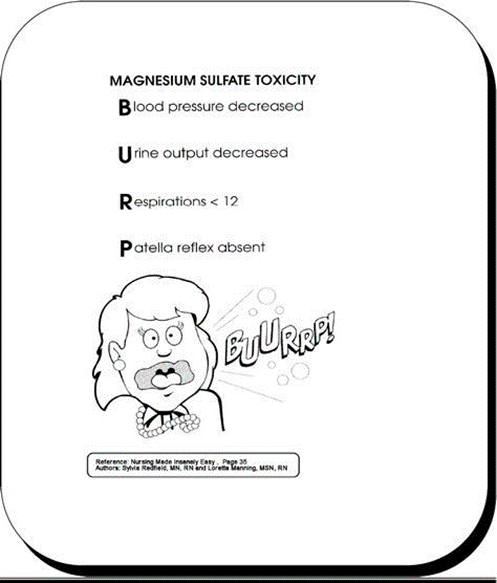A nurse is caring for a client diagnosed with preeclampsia and is being treated with magnesium sulfate IV. The client's respiratory rate is 10/min and deep-tendon reflexes are absent. Which of the following actions should the nurse take?
Assess maternal blood glucose.
Place the client in Trendelenburg position.
Prepare for an emergency cesarean birth.
Discontinue the medication infusion.
The Correct Answer is D
Explanation:
A. Assess maternal blood glucose:
While assessing blood glucose levels is important in clients receiving magnesium sulfate due to its potential effects on blood sugar, it is not the priority action in this scenario. The client's respiratory rate of 10/min and absent deep-tendon reflexes are signs of magnesium sulfate toxicity, which can lead to respiratory depression and neuromuscular effects. Therefore, the immediate concern is addressing the magnesium toxicity rather than assessing blood glucose levels.
B. Place the client in Trendelenburg position:
Placing the client in Trendelenburg position is not indicated for magnesium toxicity. The Trendelenburg position involves placing the client in a supine position with the legs elevated higher than the head. While this position may be used in some situations (e.g., hypotension), it is not appropriate for treating magnesium toxicity, respiratory depression, or absent deep-tendon reflexes. Placing the client in Trendelenburg position may worsen respiratory function and is not recommended in this case.
C. Prepare for an emergency cesarean birth:
While severe preeclampsia or eclampsia may necessitate emergency cesarean birth in some cases, it is not the immediate action needed for a client experiencing respiratory depression and absent deep-tendon reflexes due to magnesium sulfate toxicity. Cesarean birth is not the appropriate response to magnesium toxicity and would not address the client's current respiratory and neuromuscular issues. Therefore, preparing for an emergency cesarean birth is not the correct action in this scenario.
D. Discontinue the medication infusion:
This is the correct action to take. A respiratory rate of 10/min and absent deep-tendon reflexes are signs of magnesium sulfate toxicity. Magnesium sulfate, while effective in preventing seizures in preeclampsia, can lead to respiratory depression and affect neuromuscular function at toxic levels. Discontinuing the medication infusion is crucial to prevent further magnesium toxicity and adverse effects on the client's respiratory and neuromuscular status. It is the immediate and priority action needed to address the client's current condition.

Nursing Test Bank
Naxlex Comprehensive Predictor Exams
Related Questions
Correct Answer is C
Explanation
Explanation:
A. Women during labor and birth:
Maternity nursing does involve caring for women during labor and birth. Nurses in labor and delivery units provide support, monitoring, and assistance to women as they progress through labor and deliver their babies. This aspect of maternity nursing focuses specifically on the care of women during the active stages of childbirth, including pain management, labor progression, and ensuring a safe delivery experience.
B. Mothers and fathers during hospitalization for childbirth:
Maternity nursing also involves caring for both mothers and fathers during their hospitalization for childbirth. Nurses provide education, support, and assistance to new parents as they adjust to the postpartum period and learn to care for their newborns. This includes teaching about newborn care, breastfeeding support, postpartum recovery, and emotional support for the entire family unit.
C. Families during the childbearing process:
This choice is the most comprehensive and accurate description of the client focus in maternity nursing. Maternity nursing encompasses care for entire families during the entire childbearing process, from preconception to postpartum. This includes providing education, support, and guidance to expectant parents, assisting with childbirth, promoting bonding and attachment between parents and newborns, and addressing the physical and emotional needs of the family as they navigate the transitions of pregnancy, childbirth, and early parenthood.
D. Childbearing women during acute illness:
While maternity nursing does involve caring for childbearing women during periods of acute illness related to pregnancy or childbirth complications, this focus is more limited compared to the broader scope of caring for families throughout the entire childbearing process. Maternity nurses may be involved in managing complications such as preeclampsia, gestational diabetes, or postpartum hemorrhage, but their role extends beyond acute illness management to include comprehensive prenatal, intrapartum, and postpartum care for women and their families.
Correct Answer is D
Explanation
Explanation:
The safest recommendation for alcohol intake during pregnancy is to avoid alcohol completely. There is no known safe level of alcohol consumption during pregnancy, as even small amounts of alcohol can potentially harm the developing fetus. Alcohol crosses the placenta and can lead to a range of serious complications known as fetal alcohol spectrum disorders (FASDs), including physical, behavioral, and intellectual disabilities.
Whether you are a student looking to ace your exams or a practicing nurse seeking to enhance your expertise , our nursing education contents will empower you with the confidence and competence to make a difference in the lives of patients and become a respected leader in the healthcare field.
Visit Naxlex, invest in your future and unlock endless possibilities with our unparalleled nursing education contents today
Report Wrong Answer on the Current Question
Do you disagree with the answer? If yes, what is your expected answer? Explain.
Kindly be descriptive with the issue you are facing.
